Chapter 2
Stocking Up on Basic Ingredients
In This Chapter
 Making space for your new stores
Making space for your new stores
 Buying in the basics
Buying in the basics
 Using herbs, spices and condiments
Using herbs, spices and condiments
 Keeping alcohol in the kitchen
Keeping alcohol in the kitchen
 Storing foodstuffs in the fridge and freezer
Storing foodstuffs in the fridge and freezer
Dinner at the Huntercombes’ possessed only two dramatic features — the wine was a farce and the food a tragedy. — Anthony Powell, The Acceptance World, 1955
A store cupboard (or pantry) full of grains, pulses, herbs and spices will help you turn raw materials into delicious dishes full of flavour. And, if you’ve ever come home from work late just starving, you’ll learn to appreciate the beauty of a stocked store cupboard from which you can produce quick and surprisingly tasty meals.
In this chapter, we list some of the basic foodstuffs for your store cupboard, and then give detailed descriptions of the herbs, spices and condiments that give so much flavour to a recipe of otherwise quite ordinary ingredients. The chapter finishes with a few tips on how to get the best use out of your fridge and freezer, as well as a few lines about that well-known antifreeze, alcohol.
Organising Your Store Cupboard
If you’re getting serious about home cooking and have already begun to invest in some of the equipment we talk about in Chapter 1, the next step is to check out your store cupboard. Look at use-by dates and throw out anything that’s out of date. There’s no point in cooking with food that’s stale — it may not poison you, but food is about flavour and you can’t get flavour if you use stale products.
Think of your cupboard as a treasure trove of future delicious meals and take pleasure in keeping your stores tidy. As what you cook is based so much on personal taste and lifestyle, we can’t say that all the foodstuffs listed below are essential. Some things you may use a lot, some only occasionally and some not at all.
The following lists contain all the basic ingredients used in the recipes in this book, and are the foodstuffs that last. Use the lists only as an overall guide — a store cupboard is a very personal choice. Store cupboard recipes (you find them throughout this book) are really handy when unexpected guests turn up — feel a glow of pride that you’re able to give them a meal so easily; congratulate yourself on being so well-organised.
Grains
Grains are a staple food throughout the world. Without them, there would be no pasta, bread, noodles or dumplings. The grains (and the products derived from grains) that are most useful are
 Burghul: Cracked wheat (see Chapter 13).
Burghul: Cracked wheat (see Chapter 13).
 Cornflour: Made from cornmeal (see Chapter 13).
Cornflour: Made from cornmeal (see Chapter 13).
 Flour, plain and self-raising: Mostly made from wheat (see Chapters 13 and 15).
Flour, plain and self-raising: Mostly made from wheat (see Chapters 13 and 15).
 Noodles, dried: Made from a variety of grains, mostly wheat and rice (see Chapter 12).
Noodles, dried: Made from a variety of grains, mostly wheat and rice (see Chapter 12).
 Pasta, dried: Mostly made from wheat (see Chapter 12).
Pasta, dried: Mostly made from wheat (see Chapter 12).
 Rice: There are many varieties (see Chapter 13).
Rice: There are many varieties (see Chapter 13).
 Rolled oats and ground oatmeal: Made from . . . you guessed it (see Chapter 13).
Rolled oats and ground oatmeal: Made from . . . you guessed it (see Chapter 13).
Sugars and other sweet stuff
Most of us were born with a sweet tooth — wild honey and fruits were the first sweet temptations known to mankind. Sugar, mostly extracted from sugar cane, now comes in a variety of forms:
 White sugar: This is a universal sweetener.
White sugar: This is a universal sweetener.
 Caster sugar: This is a white sugar that has been ground to a finer quality; its smaller grains make it dissolve faster. It’s used in cakes and desserts.
Caster sugar: This is a white sugar that has been ground to a finer quality; its smaller grains make it dissolve faster. It’s used in cakes and desserts.
 Icing sugar: Pure icing sugar is the sweetest and finest of all white sugars; it makes a lovely soft covering for cakes, as icing or as a simple dusting.
Icing sugar: Pure icing sugar is the sweetest and finest of all white sugars; it makes a lovely soft covering for cakes, as icing or as a simple dusting.
 Raw and brown sugars: These sugars are a deep brown and rich in flavour, and add a distinctive taste to rich fruit cakes and puddings.
Raw and brown sugars: These sugars are a deep brown and rich in flavour, and add a distinctive taste to rich fruit cakes and puddings.
 Chocolate and cocoa powder: Essential for some of the best cakes and desserts — as ingredients or as toppings. Buy a good-quality, dark cooking chocolate.
Chocolate and cocoa powder: Essential for some of the best cakes and desserts — as ingredients or as toppings. Buy a good-quality, dark cooking chocolate.
 Praline: A toffee made of almonds and caramelised sugar. Crushed to sprinkle on desserts and cakes as a garnish.
Praline: A toffee made of almonds and caramelised sugar. Crushed to sprinkle on desserts and cakes as a garnish.
Pulses
Like grains, pulses are a staple food item the world over. Further information and recipes are in Chapter 13. The following are a good choice for your store cupboard:

 Dried beans and peas: Come in many different shapes.
Dried beans and peas: Come in many different shapes.
 Lentils: Green, orange, brown or yellow — make your choice after reading ‘Grains and Pulses’.
Lentils: Green, orange, brown or yellow — make your choice after reading ‘Grains and Pulses’.
 Split peas: A favourite in many cuisines.
Split peas: A favourite in many cuisines.
Baking items
Apart from flour, and the sweeteners and flavourings mentioned above, there are a number of ingredients that are essential if you plan to bake cakes, biscuits and other yummy things (like those in Chapter 15):
 Bicarbonate of soda and baking powder: These are rising agents (that is, they make cakes rise while being baked).
Bicarbonate of soda and baking powder: These are rising agents (that is, they make cakes rise while being baked).
 Desiccated coconut: This dried, finely shredded coconut makes a great crunchy topping for cakes and is a favourite addition to a biscuit mix.
Desiccated coconut: This dried, finely shredded coconut makes a great crunchy topping for cakes and is a favourite addition to a biscuit mix.
 Vanilla essence: A popular flavouring for ice cream, custards and cakes, vanilla is described in more detail in the section on spices further on in this chapter.
Vanilla essence: A popular flavouring for ice cream, custards and cakes, vanilla is described in more detail in the section on spices further on in this chapter.
Dried fruits
Drying concentrates the flavour of fruit and gives it a different but delicious kind of taste. This flavour transformation is one of the reasons fruit cakes are so popular. The following are some of the dried fruits most commonly used in baking:
 Apples, apricots, peaches and pears: All these are dried and used in baking, and are also delicious eaten straight out of the packet.
Apples, apricots, peaches and pears: All these are dried and used in baking, and are also delicious eaten straight out of the packet.
 Currants and sultanas: These are best plumped up in a little boiling water. Use them in puddings and cakes.
Currants and sultanas: These are best plumped up in a little boiling water. Use them in puddings and cakes.
 Figs, dates and prunes: These fruits, used in desserts and cakes, can be eaten straight from the packet, too.
Figs, dates and prunes: These fruits, used in desserts and cakes, can be eaten straight from the packet, too.
 Mixed orange and lemon peel: These peels add a very aromatic scent and taste to cakes and puddings.
Mixed orange and lemon peel: These peels add a very aromatic scent and taste to cakes and puddings.
 Raisins: These are used in puddings and cakes. Raisins are the dried grape of various sweet varieties, preferably dried muscat grapes. (Currants are actually small seedless raisins.)
Raisins: These are used in puddings and cakes. Raisins are the dried grape of various sweet varieties, preferably dried muscat grapes. (Currants are actually small seedless raisins.)
Canned stuff
 Artichoke hearts marinated in olive oil: Buy canned or bottled for quickly assembled snacks and salads.
Artichoke hearts marinated in olive oil: Buy canned or bottled for quickly assembled snacks and salads.
 Beans, peas and lentils: These have already been cooked, so saves you having to soak them — very handy for making fast meals.
Beans, peas and lentils: These have already been cooked, so saves you having to soak them — very handy for making fast meals.
 Coconut milk: At the drop of a can opener, you can make Thai and other Asian spicy dishes. Available in thin and thick milk, as well as cream.
Coconut milk: At the drop of a can opener, you can make Thai and other Asian spicy dishes. Available in thin and thick milk, as well as cream.
 Crab: A tempting can to have on hand for salads and sandwiches.
Crab: A tempting can to have on hand for salads and sandwiches.
 Golden syrup: A by-product of refining sugar from sugar cane, golden syrup is used to make gingerbread and some cakes and puddings. The traditional topping for a slab of hot damper straight from the coals.
Golden syrup: A by-product of refining sugar from sugar cane, golden syrup is used to make gingerbread and some cakes and puddings. The traditional topping for a slab of hot damper straight from the coals.
 Stocks: Good stocks come in cans and packets, and can save you time and effort. Beef, veal, chicken, fish and vegetable stocks are all available.
Stocks: Good stocks come in cans and packets, and can save you time and effort. Beef, veal, chicken, fish and vegetable stocks are all available.
 Tomatoes: A great stand-by, canned tomatoes can be peeled, chopped, whole, crushed, or with herbs added.
Tomatoes: A great stand-by, canned tomatoes can be peeled, chopped, whole, crushed, or with herbs added.
 Tuna: Like crab, a can of tuna can become the main ingredient for an instant sandwich, or it can be turned into a crunchy salad.
Tuna: Like crab, a can of tuna can become the main ingredient for an instant sandwich, or it can be turned into a crunchy salad.
Using Herbs for Fragrant Flavour
Table 2–1 indicates which herbs go best with what kinds of dishes. The more you use herbs in your cooking and develop an appreciation of the flavours they give food, the more your use of them becomes instinctive.
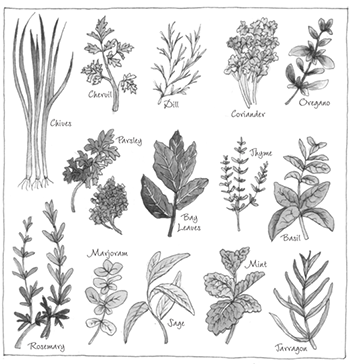
Figure 2–1: Fragrant herbs for memorable meals.
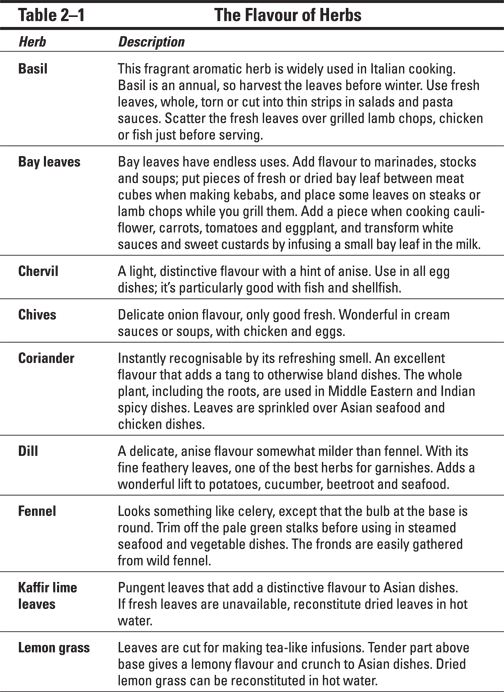
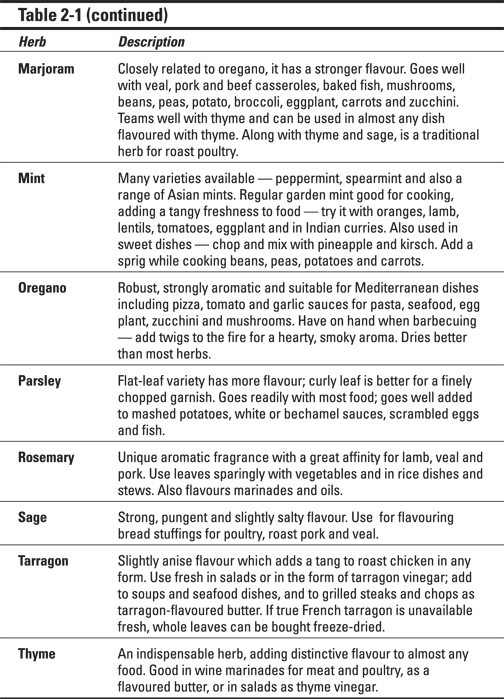
Chopping herbs
Enjoy the heady aroma released as you chop herbs. The best knife to use is a chef’s knife; follow these steps to master the technique:
1. Wash the herbs and dry them in a tea towel by wringing the towel to remove the excess water.
2. Remove any woody stems, gather the herbs into a tight ball and place them on a large chopping board.
3. Hold the handle of the knife with one hand, and hold the top of the blade near its tip with the other hand to guide the knife movements — the sharp edge should point towards the board.
Chop with rapid up-and-down movements, using the knife tip as a pivot. Sweep the herbs together and repeat the process until the herbs are chopped to the fineness desired. (See Chapter 3, where holding a chef’s knife is illustrated.)
Drying and storing herbs
It is fairly easy to get fresh herbs at all times of the year, but if you want to harvest your herb bed, tie the herbs into bundles and hang them upside down in a warm, airy place to dry. When dry, place them in paper bags,or crush them with a rolling pin and store the leaves in sealed glass jars. You can also do this with most herbs, but some, like parley and basil, don’t dry successfully.
Spicing Up Your Life
The term ‘spice’ is used to denote the products of aromatic dried roots, bark and berries, seeds and pods which mostly grow in tropical areas. Spices give a subtle aroma and flavour to simple dishes like custards and cakes, as well as to savoury dishes. Different cooking methods, such as roasting or frying, can vary the flavour of the same spice. Whole, ground and powdered spices are must-haves for the store cupboard.
Spices were prohibitively expensive until relatively recently. Even so, the more common ones have been used in Mediterranean and Asian cuisine since the beginning of written records. Many spices are now grown in Australia. Figure 2–2 illustrates the most popular spices.
All spices are not as hot as is generally believed. They actually break down into five basic categories: sweet, pungent, tangy, hot and amalgamating. Learn about spices by being conscious of the smell and taste they impart to a dish; spices are generally more concentrated than herbs. Follow good recipes exactly — you will quickly become aware of how much to use and how to combine with other spices.
In Table 2–2, we describe the different flavours and aromas of spices, and the kinds of dishes they are used in. Like herbs, the more you use spices, the greater an appreciation you develop of the flavours they give food.
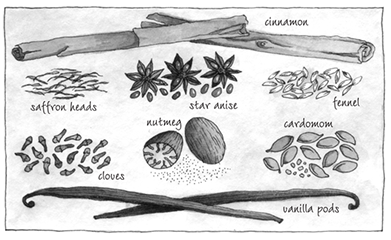
Figure 2–2: The most common spices used to flavour your dishes.
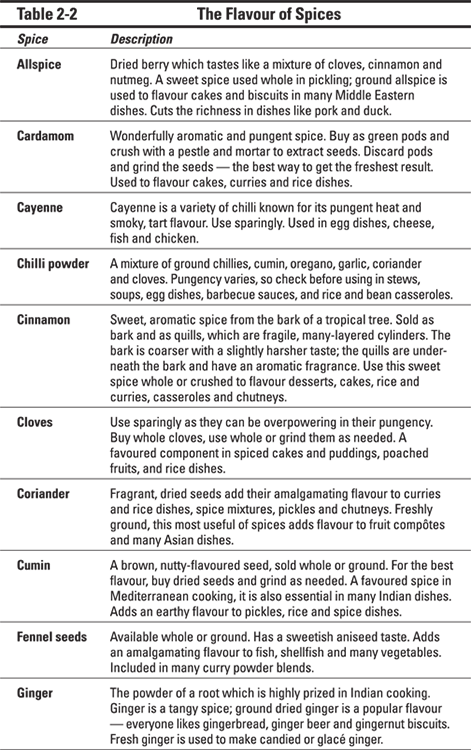
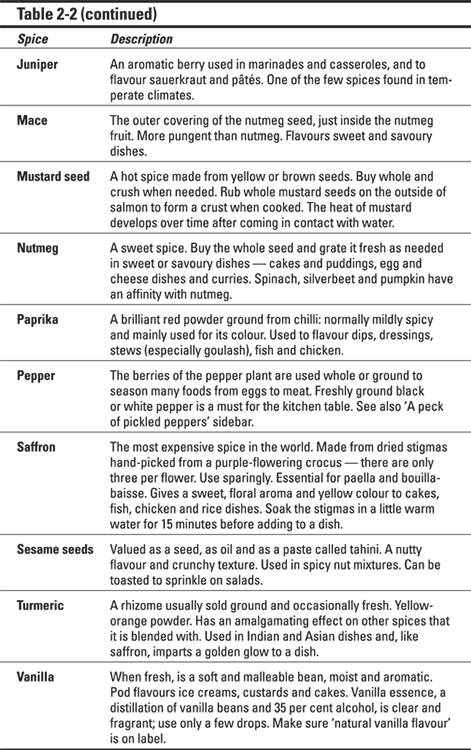
Making the most of spice mixtures
You’re probably familiar with spicy mixtures, as they are so commonly encountered in Asian restaurants in Australia and New Zealand, especially Thai, Indian and Malaysian restaurants. Three of the most common ones are
 Garam masala: A preparation of mixed spices used mostly in Indian cooking. The mixing of it is considered an art. It is used to flavour curries and other savoury dishes, and as a condiment to sprinkle over finished dishes.
Garam masala: A preparation of mixed spices used mostly in Indian cooking. The mixing of it is considered an art. It is used to flavour curries and other savoury dishes, and as a condiment to sprinkle over finished dishes.
 Malaysian laksa paste: A spicy paste made from chillies, candlenuts, spices and shrimp paste. It is used with coconut milk in laksa, a soup-like, rice noodle dish.
Malaysian laksa paste: A spicy paste made from chillies, candlenuts, spices and shrimp paste. It is used with coconut milk in laksa, a soup-like, rice noodle dish.
 Thai green curry paste: This is a wonderful blend of green chillies, lemon grass, spices and shrimp paste. It flavours and colours many Thai dishes. Thai red curry paste is similar, but is made with red chillies and gives a red finish to a dish.
Thai green curry paste: This is a wonderful blend of green chillies, lemon grass, spices and shrimp paste. It flavours and colours many Thai dishes. Thai red curry paste is similar, but is made with red chillies and gives a red finish to a dish.
Storing spices
Spices lose their flavour if they are stale, so purchase them in small quantities from an outlet with a high turnover and always check the use-by date. Store spices in small, airtight containers in a dark, dry place, and they should last up to 18 months.
Keeping Clever Condiments on Hand
Keep a stock of good-quality, prepared condiments, spreads, sweeteners and sauces either in your store cupboard or in the fridge. In Chapter 9, we discuss some of these condiments and their role in cooking. Some useful condiments are listed in Table 2–3.
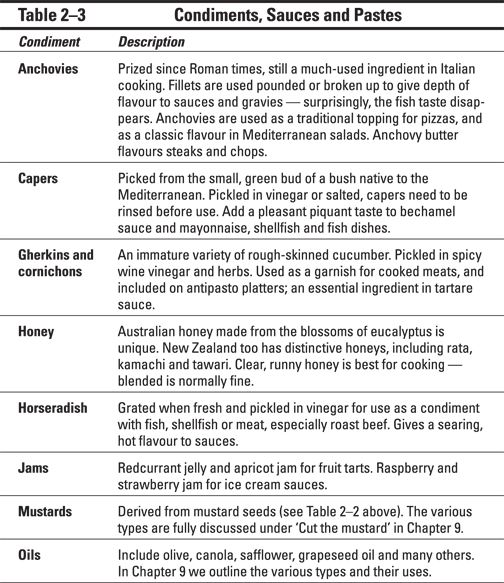
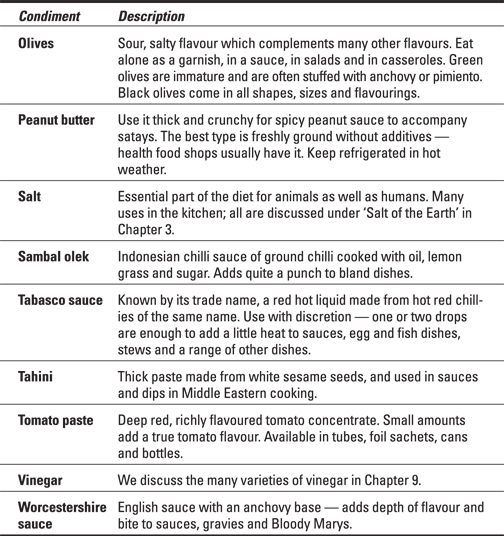
Only a few years ago, you had to visit markets and shops in suburbs with a high Asian population if you wanted to buy Asian sauces and condiments. Many are now available on supermarket shelves, and in Table 2–4 we’ve listed some of the more common ones.
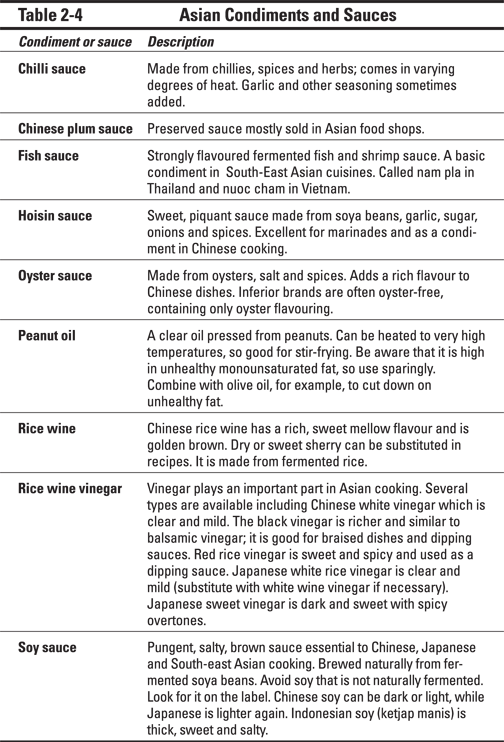
Alcohol in the Kitchen
 Beer: A rich food as well as an excellent liquid in which to slowly cook braised casseroles. It makes the best batter for fish.
Beer: A rich food as well as an excellent liquid in which to slowly cook braised casseroles. It makes the best batter for fish.
 Cointreau, kirsch and Grand Marnier: The most popular liqueurs for flavouring fresh fruits and desserts (see Chapter 14).
Cointreau, kirsch and Grand Marnier: The most popular liqueurs for flavouring fresh fruits and desserts (see Chapter 14).
 Dry and sweet sherry, madeira and port: These fortified wines are all delicious in puddings and rich fruit cakes. They make a rich pan sauce for veal and pork. A slurp of sherry also perks up bland soups.
Dry and sweet sherry, madeira and port: These fortified wines are all delicious in puddings and rich fruit cakes. They make a rich pan sauce for veal and pork. A slurp of sherry also perks up bland soups.
 Rum, Armagnac, Cognac, brandy and whisky: Are all used for flavouring sweet and savoury dishes.
Rum, Armagnac, Cognac, brandy and whisky: Are all used for flavouring sweet and savoury dishes.
 Vodka and gin: Good for marinating fish, as well as enhancing fruit salads and compôtes. The alcohol adds a light, but not overpowering, taste.
Vodka and gin: Good for marinating fish, as well as enhancing fruit salads and compôtes. The alcohol adds a light, but not overpowering, taste.
 Wine: Cooking with wine is discussed in detail in Chapter 5; ways to cook with sweet wine are found in Chapter 14.
Wine: Cooking with wine is discussed in detail in Chapter 5; ways to cook with sweet wine are found in Chapter 14.
Chilling Out
Most of the foodstuffs listed so far in this chapter keep for a reasonable length of time without refrigeration. When in doubt, check the label for instructions on storage. Many food items only need to be refrigerated when they have been opened; until then, they will keep quite happily at room temperature.
The fridge and the freezer are essential pieces of kitchen equipment — how could you get through summer without being able to reach for a cold drink or an ice cube? As familiar as you are with fridges and freezers, there are a few things to bear in mind if you’re to use them efficiently.
What’s in the fridge?
All items for refrigeration need to be either in sealed containers or plastic bags to prevent odours transferring from one foodstuff to another — you don’t want your butter smelling like the raw cut onions. Here are some useful tips on keeping food items in the fridge:
 Chill section: Some fridges have the freezer on top, so the top shelf is the coldest part of the fridge. Other fridges have the freezer on the bottom, so the coldest shelf is on top of the freezer at the bottom of the fridge. Meat is best stored unwrapped, placed on a plate and loosely covered with foil; place meat on the coldest shelf (the best area for meat is often marked). Cooked meat need not be stored in the chill section. Other foods to store in the chill section are seafood and prepared salads, and cream and milk if they don’t fit in the coldest part on the fridge door.
Chill section: Some fridges have the freezer on top, so the top shelf is the coldest part of the fridge. Other fridges have the freezer on the bottom, so the coldest shelf is on top of the freezer at the bottom of the fridge. Meat is best stored unwrapped, placed on a plate and loosely covered with foil; place meat on the coldest shelf (the best area for meat is often marked). Cooked meat need not be stored in the chill section. Other foods to store in the chill section are seafood and prepared salads, and cream and milk if they don’t fit in the coldest part on the fridge door.
 Medium-cold section: Eggs, dairy products such as butter, yoghurt and cheese, sauces, drinks and condiments like horseradish and olives should be put in the medium-cold part of the fridge. Nuts are best refrigerated to save them from going rancid.
Medium-cold section: Eggs, dairy products such as butter, yoghurt and cheese, sauces, drinks and condiments like horseradish and olives should be put in the medium-cold part of the fridge. Nuts are best refrigerated to save them from going rancid.
 Longlife storage bags: Supermarkets stock green, longlife plastic bags. They extend the shelf-life of fruit and vegetables, can be used again and again, and last for months. The bags contain natural ingredients which slow down the ageing process of fruit and vegetables and allow them to breathe more easily and so retain their freshness longer. Use separate bags for each type of fruit and vegie, and hand-wash them after each use. Place the item in the bag, being careful not to overfill, expel surplus air and close the bag.
Longlife storage bags: Supermarkets stock green, longlife plastic bags. They extend the shelf-life of fruit and vegetables, can be used again and again, and last for months. The bags contain natural ingredients which slow down the ageing process of fruit and vegetables and allow them to breathe more easily and so retain their freshness longer. Use separate bags for each type of fruit and vegie, and hand-wash them after each use. Place the item in the bag, being careful not to overfill, expel surplus air and close the bag.
 Salad crisper: Salad leaves and fragile fruits and vegetables can be kept in the crisper and on the shelves furthest from the freezer. Though most fresh fruit won’t ripen in the fridge, the cold does inhibit deterioration, so place ripe fruit in the least cold part of the fridge.
Salad crisper: Salad leaves and fragile fruits and vegetables can be kept in the crisper and on the shelves furthest from the freezer. Though most fresh fruit won’t ripen in the fridge, the cold does inhibit deterioration, so place ripe fruit in the least cold part of the fridge.
 Hot food, cool storage: Hot food should be cooled briefly at room temperature and then put in the refrigerator, covered, while still warm. This approach will ensure that, while cooling down, the food spends minimum time in the danger zone between 5° and 65°C — this is the zone where very nasty bacteria can develop. Modern refrigerators are made to cope with this heat load.
Hot food, cool storage: Hot food should be cooled briefly at room temperature and then put in the refrigerator, covered, while still warm. This approach will ensure that, while cooling down, the food spends minimum time in the danger zone between 5° and 65°C — this is the zone where very nasty bacteria can develop. Modern refrigerators are made to cope with this heat load.
What’s in the freezer?
We discuss freezers and the ways in which the budget-conscious can get most value out of them in Chapter 16. Food should be wrapped well in quality plastic bags, in foil or in firmly sealed containers in order to avoid it acquiring frost burns. Here are some food items that should call the freezer home:
 Biscuit dough: Some mixtures can be frozen — an impressive way to be able to whip up a fresh batch of biscuits in no time (see Chapter 15 for the details).
Biscuit dough: Some mixtures can be frozen — an impressive way to be able to whip up a fresh batch of biscuits in no time (see Chapter 15 for the details).
 Bread and breadcrumbs: Slice or cut in pieces and freeze fresh homemade bread; once thawed, it will still taste fresh. Freeze the bread in slices or larger pieces. Frozen homemade breadcrumbs are a boon for the ten-minute cook.
Bread and breadcrumbs: Slice or cut in pieces and freeze fresh homemade bread; once thawed, it will still taste fresh. Freeze the bread in slices or larger pieces. Frozen homemade breadcrumbs are a boon for the ten-minute cook.
 Flavoured butters: Prepare a roll of flavoured butter (see Chapter 9) beforehand, and you just need to cut a few slices off it when frozen to add to the grill.
Flavoured butters: Prepare a roll of flavoured butter (see Chapter 9) beforehand, and you just need to cut a few slices off it when frozen to add to the grill.
 Homemade stocks: Freeze them (clearly labelled) in different-sized containers. Also, pour some stock into icetrays; when frozen, put the frozen stock cubes into plastic bags so you always have small quantities to hand.
Homemade stocks: Freeze them (clearly labelled) in different-sized containers. Also, pour some stock into icetrays; when frozen, put the frozen stock cubes into plastic bags so you always have small quantities to hand.
 Ice cubes: Always handy — make them out of mineral water or filtered water for a better taste in your drinks.
Ice cubes: Always handy — make them out of mineral water or filtered water for a better taste in your drinks.
 Ice cream and sorbet: The perfect desserts for hot days . . . or any day at all. The texture and flavour of some ice creams deteriorate the longer they are in the freezer so check use by dates.
Ice cream and sorbet: The perfect desserts for hot days . . . or any day at all. The texture and flavour of some ice creams deteriorate the longer they are in the freezer so check use by dates.
 Milk and butter: These dairy products freeze well so have a reserve in the freezer.
Milk and butter: These dairy products freeze well so have a reserve in the freezer.
 Pastry: Homemade or bought shortcrust and puff pastry keep well.
Pastry: Homemade or bought shortcrust and puff pastry keep well.
 Peas, broad beans and spinach: These commercially packed vegies survive the freezing process very well and are useful to have on hand. There is little doubt that the frozen product tastes better than the canned variety.
Peas, broad beans and spinach: These commercially packed vegies survive the freezing process very well and are useful to have on hand. There is little doubt that the frozen product tastes better than the canned variety.
 I like to visit the supermarket to do a bulk shop for my basic supplies and to keep the cupboards, refrigerator and freezer stocked up ready for surprise meals. It’s boring to make a special shopping trip every time you run out of a basic ingredient.
I like to visit the supermarket to do a bulk shop for my basic supplies and to keep the cupboards, refrigerator and freezer stocked up ready for surprise meals. It’s boring to make a special shopping trip every time you run out of a basic ingredient. 
 Don’t be fooled by unnecessary clutter in your fridge and freezer. Sometimes fridges are so full of condiments that there is hardly any room for fresh fruit and vegetables. If you think you need a bigger fridge or freezer, check what you’ve hidden away in the one you’ve already got before you go out to spend money instead of fixing the real problem. You often find that half the stuff doesn’t need to be in there anyway.
Don’t be fooled by unnecessary clutter in your fridge and freezer. Sometimes fridges are so full of condiments that there is hardly any room for fresh fruit and vegetables. If you think you need a bigger fridge or freezer, check what you’ve hidden away in the one you’ve already got before you go out to spend money instead of fixing the real problem. You often find that half the stuff doesn’t need to be in there anyway.  Please remember that, throughout this book, whenever the recipe says ‘Cool before refrigerating’, it means to cool only until the food is no longer steaming before covering and placing in the fridge.
Please remember that, throughout this book, whenever the recipe says ‘Cool before refrigerating’, it means to cool only until the food is no longer steaming before covering and placing in the fridge.